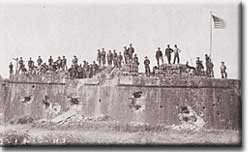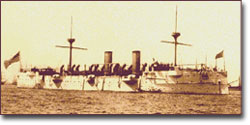44a. Early Stirrings

Manifest destiny did not die when Americans successfully lay claim to the West Coast. The newly won territory was the source of heated argument in the 1850s and a major reason for the War Between the States. Once the Union was patched back together, Americans were mostly content with settling the land already under the United States flag. But as the decades passed and America grew strong with industrial might, the desire to spread the eagle's wings over additional territory came back into vogue. Between 1890 and the start of World War I, the United States earned a seat at the table of imperial powers.
Purchase of Alaska

When William Seward proposed the purchase of Alaska in 1867, his peers thought he had gone mad. Russian America, as it was called, was a vast frozen wasteland surely not worth 7.2 million American dollars. "Seward's Folly," some scoffed. "Seward's Icebox," others razzed. The Senate saw the potential of its vast natural resources and approved the treaty, but the House stalled the purchase of the "Polar Bear Garden" for over a year. Not too much attention was paid to the new acquisition at first. Americans were too busy mending the fractured Union and then settling the continental West.
Five Near Wars
By the middle of the 1890s, it was clear that Americans were looking outward. Five near wars dotted the first half of the decade. The Samoan Islands of the South Pacific were coveted by Britain, Germany, and the United States. In 1889, the American and German navies almost exchanged gunfire before a settlement dividing the islands among the three powers could be reached. In 1891, when eleven Italians were brutally lynched in New Orleans, the United States approached a state of war with Italy before a compromise was arranged. A similar situation erupted the following year in Chile. This time, two American sailors were killed in a bar in Valparaiso. The United States government forced the Chileans to pay compensation to avoid war. Even our neighbors to the North were not immune. A fracas over seal hunting rights near Alaska caused tempers to flare. In 1895, Great Britain insisted that the boundary of its British Guiana colony included gold-enriched forest land that was also claimed by Venezuela. President Cleveland cited the Monroe Doctrine as a reason to keep the British in their own hemisphere. Threatening war with Britain if they failed to submit their claim to arbitration, the United States defended its influence in the Western Hemisphere.
The signs were clear. It had been fifty years since the United States had waged war with a foreign power, and Americans seemed to be in the mood for a fight. Little disturbances involving the likes of Venezuela, Chile, and American Samoa would not sate the desire to expand or prove America's new strength to the entire world. Soon new territories were seized, and the war that seemed inevitable finally arrived.






